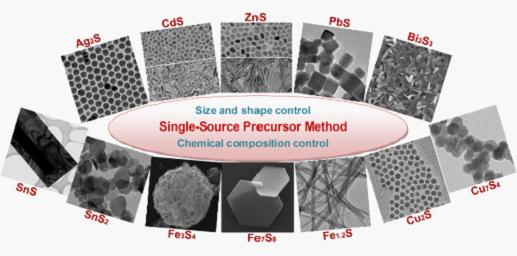Metal sulfides nanocrystals have attracted extensive investigation due to their unique optical, electrical and magnetic properties and the intriguing prospects for developments in biomedicine, optoelectronic devices and catalysis, etc. The unique properties of metal sulfides exhibit distinct size-, shape- and composition-dependence. Thus, rational design and controllable synthesis of metal sulfides with desired optical, electrical and magnetic properties are highly desirable for both fundamental studies and potential applications.
Recently, WANG Qiangbin's team of Suzhou Institute of Nano-tech and Nano-bionics (SINANO), CAS has achieved a series important progress in controllable synthesis and property study of metal sulfide nanocrystals via a facile single-source precursor approach. They established a strategy of thermal decomposing of metal-diethyldithiocarbamate (DDTC), which is simple and efficient for controllable synthesis of metal sulfides with desirable morphology, size and chemical composition. They first reported the synthesis of monodisperse Ag2S near-infrared (NIR) quantum dots (QDs) with diameter of 10nm by thermal decomposing of Ag(DDTC). Compared with the reported NIR QDs containing Pd, Cd or Hg heavy metal elements, Ag2S QDs possess excellent NIR emission property in addition to the advantage of low toxicity, which has great potential for in vivo imaging. This work has been published in J. Am. Chem. Soc. 2010, 132, 1470-1471.
ZnS as an important semiconductor have unique physical properties, such as wide band gap, high refractive index and high transmittance, and has wide applications in optoelectronic devices. Although there were many reports about the synthesis of ZnS nanomaterials, the synthesis of ZnS with a diameter smaller than the Bohr radius of ZnS still remains a challenge. Wang’s group first reported the synthesis of ultrathin ZnS nanowires (radius of 2.2 nm, smaller than its Bohr radius of 2.4 nm) in high yield (close to 100%) by the pyrolysis of Zn(DDTC)2 in oleylamine. Further study indicated that the morphology of ZnS can be tuned by the ligand in the solution. For example, ZnS QDs were obtained by adding oleic acid in oleylamine as co-solvents. These results were published in Chem. Commun. 2010, 46, 8941-8943.
In addition to the metal sulfide with unique optical properties, progress in controllable synthesis of magnetic sulfide also has been made and diverse-shaped iron sulfide nanostructures were successfully synthesized via their single-source precursor method. The mechanism of shape evolution of iron sulfide nanostructures was systematically studied. The results showed that cubic phase Fe3S4 nanoparticles and monoclinic phase Fe7S8 nanoplates with strong ferromagnetism at room temperature were obtained by using Fe(DDTC)3 and Fe(DDTC)2(Phen) as precursors, respectively. Fe1.2S nanoribbons with weak ferromagnetism were obtained by further tuning the experimental condition. (CrystEngComm. 2010, 12, 3658-3663).
Based on above studies, the single-source precursor approach was further applied to synthesis of tin sulfide. Uniform, ultralarge single crystal SnS rectangular nanosheets (7000 nm × 3000 nm × 20 nm) were successfully obtained. The as-prepared SnS nanosheets with unique 2D structure and reduced thickness exhibited excellent electrochemical properties as anode material for Li-ion battery with a capacity of 350 mAh/g around 1.2 V and appealing cycling reversibility. Uniform SnS2 hexagonal nanoplates were also obtained by easily tuning the reaction conditions (Chem. Commun. 2011, 47, 5226-5228).
In addition to the above mentioned metal sulfides, CdS QDs and nanorods, PbS nanocubes, Bi2S3 nanoplates, Cu2S QDs and Cu7S4 nanoparticles (candidate material in photovoltaic devices) were also successfully synthesized via the single-source precursor method. A review for this method and the achieved progress has been published by CrystEngComm (DOI: 10.1039/C0CE00982B). With this single-source precursor method, not only the size and shape but also the chemical composition of metal sulfide can be precisely controlled, which allows for further systematic investigation of their novel properties and application thereof.
These researches were supported by “Hundred Talents Program” of the CAS, “Strategic Priority Research Program” of the CAS, NSFC, MOST, CAS/SAFEA International Partnership Program for Creative Research Teams.
 |
| Image by WANG Qiangbin, SINANO |

